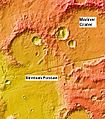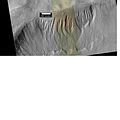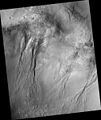- Martian Gullies
-
First discovered on images from Mars Global Surveyor, Martian gullies may be the site of recent liquid water. Gullies occur on steep slopes, especially on the walls of craters. Gullies are believed to be relatively young because they have few, if any craters. Moreover, they lie on top of sand dunes which themselves are considered to be quite young. Usually, each gully has an alcove, channel, and apron. Some studies have found that gullies occur on slopes that face all directions,[1] others have found that the greater number of gullies are found on poleward facing slopes, especially from 30-44 S.[2] Although thousands have been found, they appear to be restricted to only certain areas of the planet. Most occur 30 degrees poleward in each hemisphere with greater numbers in the southern hemisphere. In the northern hemisphere, they have been found in Arcadia Planitia, Tempe Terra, Acidalia Planitia, and Utopia Planitia.[3] In the south, high concentrations are found on the northern edge of Argyre basin, in northern Noachis Terra, and along the walls of the Hellas outflow channels.[3]
Contents
How were they formed?
After being discovered many ideas were put forward to explain the gullies.[4] However, as in the usual progression of science, some ideas came to be more plausible than others when more observations were made, when other instruments were used, and when statistical analysis was employed. Even through some gullies resembled debris flows on Earth, it was found that many gullies were on slopes that were not steep enough for typical debris flows. Calculations showed that the pressure and temperatures were not right for liquid carbon dioxide. Moreover, the winding shape of the gullies suggested that the flows were slower than what would be produced in debris flows or eruptions of liquid carbon dioxide. Liquid carbon dioxide would sort of explode out of the ground in the thin Martian atmosphere. Because the liquid carbon dioxide would throw material over 100 meters, the channels should be discontinuous, but they are not.[5] Eventually, the most popular theories came to involve liquid water coming from an aquifer, from melting at the base of old glaciers (or snowpacks), or from the melting of ice in the ground when the climate was warmer.[5][6] Because of the good possibility that liquid water was involved with their formation and that they could be very young, scientists are excited. Maybe the gullies are where we should go to find life. However, more studies open up other posibilities; a study released in October 2010, contends that some gullies, the ones on sand dunes, may be produced by a build up of solid carbon dioxide during cold winter months.[7][8]
Aquifers
Most of the gully alcove heads occur at the same level, just as one would expect if water came out of an aquifer. Various measurements and calculations show that liquid water could exist in aquifers at the usual depths where gullies begin.[5] One variation of this model is that rising hot magma could have melted ice in the ground and caused water to flow in aquifers. Aquifers are layers that allow water to flow. They may consist of porous sandstone. The aquifer layer would be perched on top of another layer that prevents water from going down (in geological terms it would be called impermeable). Because water in an aquifer is prevented from going down, the only direction the trapped water can flow is horizontally. Eventually, water could flow out onto the surface when the aquifer reaches a break—like a crater wall. The resulting flow of water could erode the wall to create gullies.[9] Aquifers are quite common on Earth. A good example is "Weeping Rock" in Zion National Park Utah.[10] However, the idea that aquifers formed the gullies does not explain the ones found on isolated peaks, like knobs and the central peaks of craters. Also, a type of gully seems to be present on sand dunes. Aquifers need a wide collecting area which is not present on sand dunes or on isolated slopes. Even though most of the original gullies that were seen seemed to come from the same layer in the slope, some exceptions to this pattern have been found.[11] Examples of gullies coming from different levels is shown below in the image of Lohse Crater and the image of gullies in Ross Crater.
-
Gully on mound as seen by Mars Global Surveyor, under the Public Target Program. Images of gullies on isolated peaks, like this one, are difficult to explain with the theory of water coming from aquifers because aquifers need large collecting areas.
-
Lohse Crater Gullies on Central Peak, as seen by HiRISE. This is an example of gullies occurring on the isolated central peak of a crater. It is difficult to reconcile this with the idea that water comes from aquifers to erode gullies. In addition, the gullies in this image do not appear to originate from the same level.
Snowpacks
As for the next theory, much of the surface of Mars is covered by a thick smooth mantle that is thought to be a mixture of ice and dust.[12] [13] [14] This ice-rich mantle, a few yards thick, smoothes the land, but in places it has a bumpy texture, resembling the surface of a basketball. The mantle may be like a glacier and under certain conditions the ice that is mixed in the mantle could melt and flow down the slopes and make gullies.[15] [16] Calculations show that a third of a mm of runoff can be produced each day for 50 days of each Martian year even under current conditions.[17] Because there are few craters on this mantle, the mantle is relatively young. An excellent view of this mantle is shown below in the picture of the Ptolemaeus Crater Rim, as seen by HiRISE.[18]
The ice-rich mantle may be the result of climate changes.[19] Changes in Mars's orbit and tilt cause significant changes in the distribution of water ice from polar regions down to latitudes equivalent to Texas. During certain climate periods water vapor leaves polar ice and enters the atmosphere. The water comes back to ground at lower latitudes as deposits of frost or snow mixed generously with dust. The atmosphere of Mars contains a great deal of fine dust particles. Water vapor will condense on the particles, then fall down to the ground due to the additional weight of the water coating. When Mars is at its greatest tilt or obliquity, up to 2 cm of ice could be removed from the summer ice cap and be deposited at midlatitudes. This movement of water could last for several thousand years and create a snow layer of up to around 10 meters thick.[20][21] When ice at the top of the mantling layer goes back into the atmosphere, it leaves behind dust, which insulating the remaining ice.[22]
When the slopes, orientations, and elevations of thousands of gullies were compared, clear patterns emerged from the data. Measurements of altitudes and slopes of gullies support the idea that snowpacks or glaciers are associated with gullies. Steeper slopes have more shade which would preserve snow.[23] Higher elevations have far fewer gullies because ice would tend to sublimate more in the thin air of the higher altitude. For example, Thaumasia quadrangle is heavily cratered with many steep slopes. It is in the right latitude range, but its altitude is so high that there is not enough pressure to keep ice from sublimating (going directly from a solid to a gas); hence it does not have gullies.[24][25] A large study done with several years worth of data from Mars Global Surveyor showed that there is a tendency for gullies to be on poleward facing slopes; these slopes have more shade that would keep snow from melting and allow large snowpacks to accumulate.[23]
In general, it is now believed that during periods of high obliquity, the ice caps will melt causing higher temperature, pressure, and moisture. The moisture will then accumulate as snow in midlatitudes, especially in the more shaded areas--pole facing, steep slopes. At a certain time of the year, sunlight will melt snow with the resulting water producing gullies.
Melting of surface ice
The third theory might be possible since climate changes may be enough to simply allow ice in the ground to melt and thus form the gullies. During a warmer climate, the first few meters of ground could thaw and produce a "debris flow" similar to those on the dry and cold Greenland east coast.[26] Since the gullies occur on steep slopes only a small decrease of the shear strength of the soil particles is needed to begin the flow. Small amounts of liquid water from melted ground ice could be enough.[27][28][dead link]
How changing tilt affects the climate
It is generally believed that a few million years ago, the tilt of the axis of Mars was 45 degrees instead of its present 25 degrees.[29] Its tilt, also called obliquity, varies greatly because its two tiny moons cannot stabilize it, like our relatively large moon does to the Earth.[30][31] During such periods of high tilt, the summer rays of the sun strike the mid-latitude crater surfaces straight on, thus the surface remains dry.
Note that at high tilt, the ice caps at the poles disappear, the atmosphere thickness, and the moisture in the atmosphere goes up. These conditions cause snow and frost to appear on the surface. However, any snow that falls at night and during the cooler parts of the day disappears when the day warms.
Things are quite different as fall approaches, for the pole-facing slopes remain in the shade all day. Shade causes snow to accumulate through the fall and winter seasons.
In the spring at certain point, the ground will be warm enough and the air pressure high enough for liquid water to form at certain times of the day. There may be sufficient water to produce gullies by erosion.[16] Or, the water may soak into the ground, and later move down as a debris flow. Gullies on Earth formed by this process resemble Martian gullies. The great changes in the tilt of Mars explain both the strong relationship of gullies to certain latitude bands and the fact that the vast majority of gullies exist on shady, pole-facing slopes. Models support the idea that pressure/temperature changes during high obliquity times are enough to allow liquid water to be stable in places where gullies are common.
Gullies in Phaethontis quadrangle
The Phaethontis quadrangle is the location of many gullies that may be due to recent flowing water. Some are found in the Gorgonum Chaos[32][33] and in many craters near the large craters Copernicus and Newton (Martian crater).[34][35]
-
Gorgonum Chaos as seen by Mars Reconnaissance Orbiter HiRISE. Image about 4 km wide.
-
Group of gullies on north wall of crater that lies west of the crater Newton (41.3047 degrees south latitude, 192.89 east longitide). Image taken with Mars Global Surveyor under the public target program.
-
HiRISE image, taken under HiWish program, of gullies in a crater in Terra Sirenum.
-
Gullies with remaines of a former glacier in crater in Terra Sirenum, as seen by HiRISE under HiWish program.
-
Gullies in a crater in Terra Sirenum, as seen by HiRISE under the HiWish Program.
Eridania quadrangle Gullies
-
Gullies in a crater in Eridania, north of the large crater Kepler. Also, features that may be remains of old glaciers are present. One, to the right, has the shape of a tongue. Image taken with Mars Global Surveyor.
Argyre quadrangle Gullies
-
Gullies on the western rim of Argyra Planitia as seen with CTX.
-
Charitum Montes Gullies, as seen by HiRISE.
Thaumasia quadrangle Gullies
See also
- Climate of Mars
- Water on Mars
- Geology of Mars
- Phaethontis quadrangle
- Eridania quadrangle
- Argyre quadrangle
- Thaumasia quadrangle
References
- ^ Edgett, K. et al. (2003). "Polar-and middle-latitude martian gullies: A view from MGS MOC after 2 Mars years in the mapping orbit" (PDF). Lunar Planet. Sci. 34: Abstract 1038. Bibcode 2003LPI....34.1038E. http://www.lpi.usra.edu/meetings/lpsc2003/pdf/1038.pdf.
- ^ Dickson, J; Head, J; Kreslavsky, M (2007). "Martian gullies in the southern mid-latitudes of Mars: Evidence for climate-controlled formation of young fluvial features based upon local and global topography" (PDF). Icarus 188: 315–323. Bibcode 2007Icar..188..315D. doi:10.1016/j.icarus.2006.11.020. http://www.planetary.brown.edu/pdfs/3138.pdf.
- ^ a b Heldmann, J; Carlsson, E; Johansson, H; Mellon, M; Toon, O (2007). "Observations of martian gullies and constraints on potential formation mechanismsII. The northern hemisphere". Icarus 188: 324. Bibcode 2007Icar..188..324H. doi:10.1016/j.icarus.2006.12.010.
- ^ http://www.psrd.hawaii.edu/Aug03/MartianGullies.html
- ^ a b c Heldmann, J (2004). "Observations of martian gullies and constraints on potential formation mechanisms". Icarus 168: 285–304. Bibcode 2004Icar..168..285H. doi:10.1016/j.icarus.2003.11.024.
- ^ Forget, F. et al. 2006. Planet Mars Story of Another World. Praxis Publishing. Chichester, UK.
- ^ NASA/Jet Propulsion Laboratory. "Study links fresh Mars gullies to carbon dioxide." ScienceDaily 30 October 2010. 10 March 2011
- ^ Diniega, S.; Byrne, S.; Bridges, N. T.; Dundas, C. M.; McEwen, A. S. (2010). "Seasonality of present-day Martian dune-gully activity". Geology 38: 1047. doi:10.1130/G31287.1.
- ^ Mars Gullies Likely Formed By Underground Aquifers. Leonard David, 12 November 2004 (Space.com)
- ^ Harris, A and E. Tuttle. 1990. Geology of National Parks. Kendall/Hunt Publishing Company. Dubuque, Iowa
- ^ Foget, F. et al. 2006. Planet Mars Story of Another World. Praxis Publishing. Chichester, UK
- ^ Malin, Michael C.; Edgett, Kenneth S. (2001). "Mars Global Surveyor Mars Orbiter Camera: Interplanetary cruise through primary mission". Journal of Geophysical Research 106: 23429–23570. Bibcode 2001JGR...10623429M. doi:10.1029/2000JE001455.
- ^ Mustard, JF; Cooper, CD; Rifkin, MK (2001). "Evidence for recent climate change on Mars from the identification of youthful near-surface ground ice.". Nature 412 (6845): 411–4. doi:10.1038/35086515. PMID 11473309. http://www.planetary.brown.edu/pdfs/2610.pdf.
- ^ Carr, Michael H. (2001). "Mars Global Surveyor observations of Martian fretted terrain". Journal of Geophysical Research 106: 23571–23595. Bibcode 2001JGR...10623571C. doi:10.1029/2000JE001316.
- ^ Martian gullies could be scientific gold mines. Leonard David, 11/13/2006.
- ^ a b Head, JW; Marchant, DR; Kreslavsky, MA (2008). "Formation of gullies on Mars: Link to recent climate history and insolation microenvironments implicate surface water flow origin". PNAS 105 (36): 13258–63. Bibcode 2008PNAS..10513258H. doi:10.1073/pnas.0803760105. PMC 2734344. PMID 18725636. http://www.pubmedcentral.nih.gov/articlerender.fcgi?tool=pmcentrez&artid=2734344.
- ^ Clow, G (1987). "Generation of liquid water on Mars through the melting of a dusty snowpack". Icarus 72: 93–127. Bibcode 1987Icar...72...95C. doi:10.1016/0019-1035(87)90123-0.
- ^ Christensen, PR (2003). "Formation of recent martian gullies through melting of extensive water-rich snow deposits.". Nature 422 (6927): 45–8. doi:10.1038/nature01436. PMID 12594459.
- ^ http://news.nationalgeographic.com/news/2008/03/080319-mars-gullies_2.html
- ^ Jakosky, Bruce M.; Carr, Michael H. (1985). "Possible precipitation of ice at low latitudes of Mars during periods of high obliquity". Nature 315 (6020): 559–561. Bibcode 1985Natur.315..559J. doi:10.1038/315559a0.
- ^ Jakosky, Bruce M.; Henderson, Bradley G.; Mellon, Michael T. (1995). "Chaotic obliquity and the nature of the Martian climate". Journal of Geophysical Research 100: 1579–1584. Bibcode 1995JGR...100.1579J. doi:10.1029/94JE02801.
- ^ MLA NASA/Jet Propulsion Laboratory (December 18, 2003). "Mars May Be Emerging From An Ice Age". ScienceDaily. http://www.sciencedaily.com/releases/2003/12/031218075443.htm. Retrieved February 19, 2009.
- ^ a b Dickson, J; Head, J; Kreslavsky, M (2007). "Martian gullies in the southern mid-latitudes of Mars: Evidence for climate-controlled formation of young fluvial features based upon local and global topography" (PDF). Icarus 188: 315–323. Bibcode 2007Icar..188..315D. doi:10.1016/j.icarus.2006.11.020. http://www.planetary.brown.edu/pdfs/3138.pdf.
- ^ Kreslavsky, Mikhail A.; Head, James W. (2000). "Kilometer-scale roughness of Mars: Results from MOLA data analysis" (PDF). Journal of Geophysical Research 105: 26695–26712. Bibcode 2000JGR...10526695K. doi:10.1029/2000JE001259. http://www.planetary.brown.edu/pdfs/2447.pdf.
- ^ Hecht, M (2002). "Metastability of liquid water on Mars" (PDF). Icarus 156: 373–386. Bibcode 2002Icar..156..373H. doi:10.1006/icar.2001.6794. http://www.geo.brown.edu/geocourses/geo292/papers/Hecht2002.pdf.
- ^ Peulvast, J.P. (1988). "Mouvements verticaux et genèse du bourrelet Est-groenlandais. dans la région de Scoresby Sund" (in French). Physio Géo 18: 87–105.
- ^ Costard, F. et al. (2001). "Debris Flows on Mars: Analogy with Terrestrial Periglacial Environment and Climatic Implications" (PDF). Lunar and Planetary Science XXXII. Bibcode 2001LPI....32.1534C. http://www.lpi.usra.edu/meetings/lpsc2001/pdf/1534.pdf.
- ^ http://www.spaceref.com/16090/news/viewpr.html?pid=7124
- ^ Hugh H. Kieffer (1992). Mars. University of Arizona Press. ISBN 9780816512577. http://books.google.com/books?id=NoDvAAAAMAAJ. Retrieved 7 March 2011.
- ^ Jakosky, Bruce M.; Carr, Michael H. (1985). "Possible precipitation of ice at low latitudes of Mars during periods of high obliquity". Nature 315 (6020): 559–561. Bibcode 1985Natur.315..559J. doi:10.1038/315559a0.
- ^ Jakosky, Bruce M.; Henderson, Bradley G.; Mellon, Michael T. (1995). "Chaotic obliquity and the nature of the Martian climate". Journal of Geophysical Research 100: 1579–1584. Bibcode 1995JGR...100.1579J. doi:10.1029/94JE02801.
- ^ Gorgonum Chaos Mesas (HiRISE Image ID: PSP_004071_1425
- ^ Gullies on Gorgonum Chaos Mesas (HiRISE Image ID: PSP_001948_1425)
- ^ Gullies in Newton Crater (HiRISE Image ID: PSP_004163_1375)
- ^ U.S. department of the Interior U.S. Geological Survey, Topographic Map of the Eastern Region of Mars M 15M 0/270 2AT, 1991
External links
- VEDIE et al., 2008 : Laboratory simulations of martian gullies on the Russel crater sand dunes <http://www.agu.org/pubs/crossref/2008/2008GL035638.shtml>
- [1] Gives a general review of many of the theories involving the origin of gullies.
- Dickson, J; Head, J; Kreslavsky, M (2007). "Martian gullies in the southern mid-latitudes of Mars: Evidence for climate-controlled formation of young fluvial features based upon local and global topography" (PDF). Icarus 188: 315–323. Bibcode 2007Icar..188..315D. doi:10.1016/j.icarus.2006.11.020. http://www.planetary.brown.edu/pdfs/3138.pdf. Gives a good review of the history of the discovery of gullies.
Categories:
Wikimedia Foundation. 2010.


































